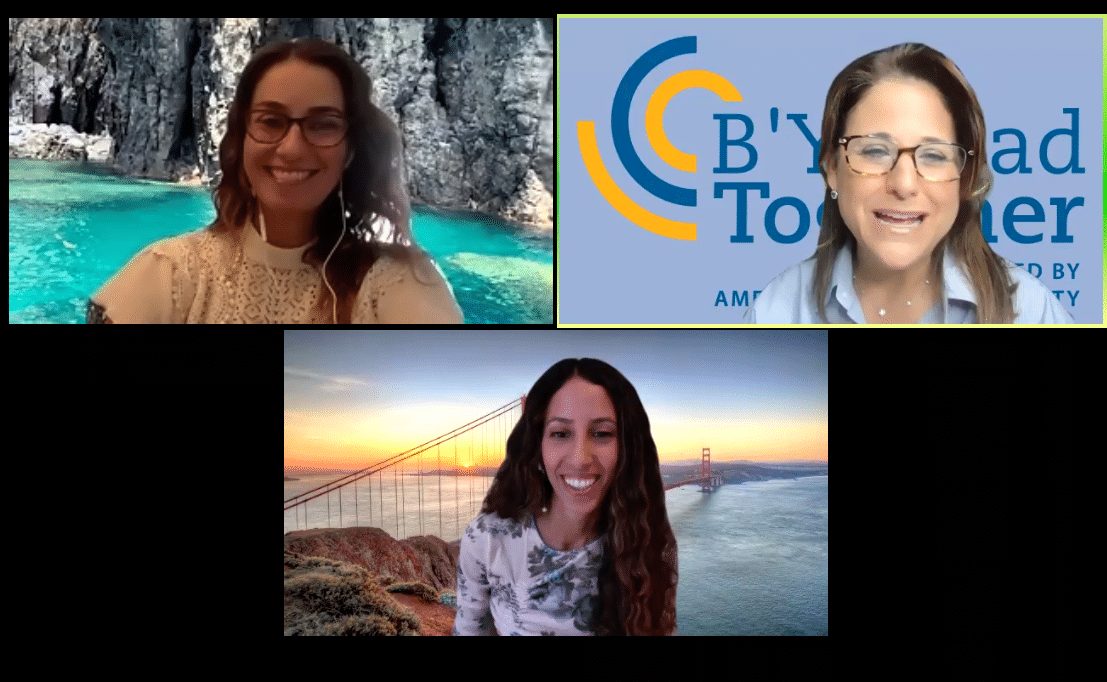 From left: Saba Soomekh, Rabbi Sherre Hirsch and Liana Kadisha Cohn.
From left: Saba Soomekh, Rabbi Sherre Hirsch and Liana Kadisha Cohn. American Jewish University (AJU) hosted an online panel on Aug. 3 with two Jewish Iranian women as part of its B’Yachad Together series. Titled “Two Emerging Persian Voices Talk Honestly About Divisions and Unity,” associate director at the American Jewish Committee Los Angeles (AJC-LA) and lecturer at the Academy for Jewish Religion-CA Saba Soomekh and Switch and Paymaxs founder and AJC board member Liana Kadisha Cohn spoke with AJU Chief Innovation Officer Rabbi Sherre Hirsch.
In deciding to host the two women, Hirsch told the Journal, “It was a natural thing that [we] started highlighting all the different types of Jews and communities that are out there. [I said,] ‘Saba and Liana, both of you are such shining examples of Persian women who have really been exemplary.’ And [they have] done it [their] own way. Liana for going to Stanford, speaking Mandarin and working on an Israeli ambulance, Saba being an academic, teaching at UCLA. They’ve broken ground [for] any person, let alone Persians, let alone a woman. So, I said, ‘What would it look like if we had a conversation?’ ”
Hirsch added that her interest in the Persian community dates back to 1996 when she became the first female rabbi at Sinai Temple, which had a congregation with a strong Iranian contingent. She remained at Sinai Temple for eight years and said many congregants thought she was Iranian. They spoke to her in Farsi and she gave a speech from the pulpit about what Ashkenazi Jews could learn from Iranian Jews. Since then, she said, she has admired the intimacy and connection that people from the Persian culture bring to their Friday night Shabbat meals and to their Judaism as a whole.
Introducing Soomekh and Kadisha Cohn at the event, Hirsch revealed that she had known them both for many years and was “kvelling,” to introduce them. “I was your teacher and now I get to be your student,” she said.
Hirsch then asked them about the origins and definitions of Sephardic, Persian, Iranian and Ashkenazi culture and history. Although many Iranian Jews identify as Sephardic, Soomekh debunked the idea that they were Sephardic unless their families were from Spain or Portugal (the Iberian Peninsula). Rather, she said, it’s the term Mizrahi that should be used. She noted it’s a term used less in America but all the time in Israel. “It literally means ‘Jews from the East,’ ” she said. “Sephardic and Mizrahi are actually very different terms because the Mizrahi Jewish community, specifically the Iranian Jewish community, goes back to Iran — at that time Persia — from 2,700 years ago. We are the oldest community in the Diaspora.”
“Not all Jews are white or look white. A lot of people I had met had not even known that there were Iranian Jews.” — Liana Kadisha Cohn
She then went on to say, “Persia doesn’t exist anymore … but Persian Jews use that term because I think it invokes a time when they felt they lived in a country where there was religious pluralism and where Judaism, or at least the Jewish community, was being respected.”
When Kadisha Cohn’s parents arrived in Los Angeles, they stayed in a motel before realizing their children had been out of school for close to a year. That’s when they enrolled them in school and began their life in L.A.
“Finally, they realized they’re not going back,” Soomekh added.
The women also addressed common stereotypes including that “not all Jews are white or look white,” Kadisha Cohn said. “A lot of people I had met had not even known that there were Iranian Jews.”
They also spoke about insularity within the community, in addition to the misconception that all Iranians are wealthy. Some do not have money for rent, food and basic necessities, Soomekh said, adding, “We’re not a homogenous community.”
Michelle Naim has a bachelor’s degree in English-Journalism from Yeshiva University and is a former Journal intern. She’s on Twitter at @michnaim.






















 More news and opinions than at a Shabbat dinner, right in your inbox.
More news and opinions than at a Shabbat dinner, right in your inbox.